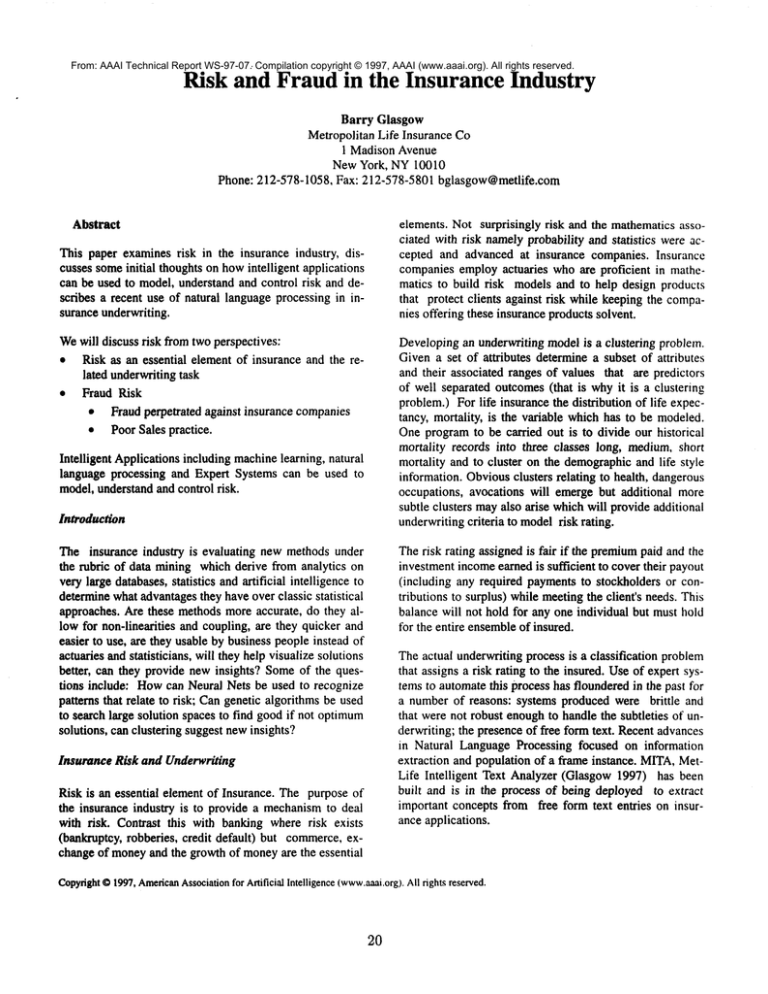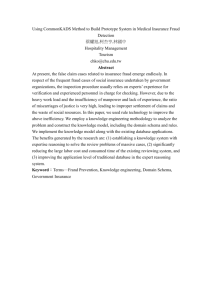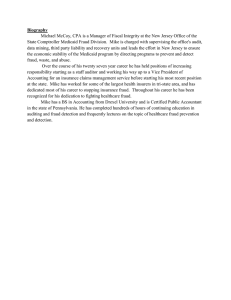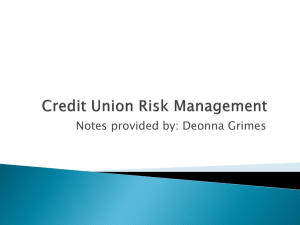
From: AAAI Technical Report WS-97-07. Compilation copyright © 1997, AAAI (www.aaai.org). All rights reserved.
Risk and Fraud in the Insurance Industry
Barry Glasgow
Metropolitan Life Insurance Co
1 Madison Avenue
New York, NY I0010
Phone: 212-578-1058, Fax: 212-578-5801 bglasgow@metlife.com
Abstract
elements. Not surprisingly risk and the mathematics associated with risk namelyprobability and statistics were accepted and advanced at insurance companies. Insurance
companies employ actuaries who are proficient in mathematics to build risk models and to help design products
that protect clients against risk while keeping the companies offering these insurance products solvent.
This paper examines risk in the insurance industry, discusses someinitial thoughts on howintelligent applications
can be used to model, understand and control risk and describes a recent use of natural language processing in insurance underwriting.
Wewill discuss risk from two perspectives:
¯ Risk as an essential element of insurance and the related underwriting task
¯
Fraud Risk
¯ Fraud perpetrated against insurance companies
¯ Poor Sales practice.
Developing an underwriting modelis a clustering problem.
Given a set of attributes determine a subset of attributes
and their associated ranges of values that are predictors
of well separated outcomes(that is whyit is a clustering
problem.) For life insurance the distribution of life expectancy, mortality, is the variable which has to be modeled.
One program to be carded out is to divide our historical
mortality records into three classes long, medium,short
mortality and to cluster on the demographicand life style
information. Obviousclusters relating to health, dangerous
occupations, avocations will emerge but additional more
subtle clusters mayalso arise whichwill provide additional
underwritingcriteria to modelrisk rating.
Intelligent Applications including machinelearning, natural
language processing and Expert Systems can be used to
model, understandand control risk.
Introduction
The insurance industry is evaluating new methods under
the rubric of data mining which derive from analytics on
very large databases, statistics and artificial intelligence to
determinewhat advantages they have over classic statistical
approaches. Are these methods more accurate, do they allow for non-linearities and coupling, are they quicker and
easier to use, are they usable by business people instead of
actuaries and statisticians, will they help visualize solutions
better, can they provide new insights? Someof the questions include: Howcan Neural Nets be used to recognize
patterns that relate to risk; Cangenetic algorithms be used
to search large solution spaces to find goodif not optimum
solutions, can clustering suggest newinsights?
Insurance Risk and Underwriting
Risk is an essential element of Insurance. The purpose of
the insurance industry is to provide a mechanismto deal
with risk. Contrast this with banking where risk exists
(bankruptcy, robberies, credit default) but commerce,exchange of moneyand the growth of moneyare the essential
The risk rating assigned is fair if the premiumpaid and the
investmentincomeearned is sufficient to cover their payout
(including any required payments to stockholders or contributions to surplus) while meetingthe client’s needs. This
balance will not hold for any one individual but must hold
for the entire ensembleof insured.
The actual underwriting process is a classification problem
that assigns a risk rating to the insured. Use of expert systems to automatethis process has floundered in the past for
a number of reasons: systems produced were brittle and
that were not robust enoughto handle the subtleties of underwriting; the presence of free form text. Recent advances
in Natural Language Processing focused on information
extraction and population of a frame instance. MITA,MetLife Intelligent Text Analyzer (Glasgow 1997) has been
built and is in the process of being deployed to extract
important concepts from free form text entries on insurance applications.
Copyright
©1997.American
Association
for ArtificialIntelligence(www.aaai.org).
All rightsreserved.
20
Insurance companies, as do brokerage companies, have a
compliance department responsible for the detection of
poor sales practices.
Fraud as a Risk
Fraud is both perpetrated on insurance companies and unfortunately fraud, in the sense of poor sales practice, is
someumesperpetrated by rogue personal at an insurance
company.
Fraud detection
learning
and supervised
and unsupervised
In areas of insurance where customer claims are frequent
such as Property and Casualty, Health and long term disability customerfraud exists. It is estimated that 10%of all
property and casualty claims submitted are fraudulent.
Medicalclaims fraud discovery and prevention is similar to
problems faced by Credit Card and Telcos. An individual,
health practitioner or claims adjuster is involvedin a series
of transactions. Individually each transaction makessense
but collectively the set of transactions is suspicious. Unlike
credit card fraud real-time analysis is not required. Association rules, sequential analysis visualization tools similar
to those used to detect moneylaundering are helpful in
detecting these problems.
If examplesof fraud and non-fraud cases exist then supervised learning can be used to determine the relationship
betweenattributes and the occurrence of fraud.
In someinsurance areas, particularly Personal Insurance,
poor sales practice have to be detected. Similar problems
also occur in the brokerage industry. Somesales people are
motivated by greed and their ownself interest at the expense of thetr clients and the firm. Recently Prudential Insurance has agreed to resolve complaints of allegedly deceptive sales practice for over 400Million dollars.
Processing CustomerComplaint Letters. MetLife has nine
million active life insurance customers. A 1%complaint
level generates 90Kletters per year. At 30 minutes/letter
this would require 45 thousand hours, about 20 people to
read and digest customer complaints. Someof these letters
are hand written, but many letters are word processed
documentsfrom clients, state insurance departments or law
firms. Can Information Extraction be used to: build a frame
for each complaint; describe any attached documents;build
an index; generate a strategy for handling; find additional
records relating to this case, client, product, sales person;
generate a draft of a response; based on similarities of
complaints evaluate potential for class action suit; be an
intelligent agent to bring potential serious situations to the
attention of senior management?
Sales practice violations can take several forms:
Misrepresentation of product information Including
false Illustrations or claiming features that a product
does not have. AnIllustration is a particular class of
insurance product/client literature that showshowthe
coverage, dividends, cash value and premiumchange
over time for a particular product and client.
Supervised learning can be used to find patterns of known
fraud. Howeversalespeople are particularly adapt at varying their pattern so supervised learning is not sufficient.
Unsupervisedlearning can be used to cluster sales records,
and the presence of small cluster would be indicative of
novel sales practices which would require more detailed
analysis.
Natural Language Processing
Fraud Detection on hierarchical data
Selling an unsuitable product to a client. Unsuitable
products do not have the benefits required by the client
or have a cost structure not commensuratewith the
benefits. In the brokerage industry a similar problems
arises when the product being sold does not have an
appropriate risk/reward profile. Sometimesthe situation ts complexi.e., life insurance to 70 year widower
with no dependents (what about if he was contemplating getting married?)
Churningis the practice of converting an existing policy into a new policy, generating additional commission for the agent without commensuratebenefits to
the customer.
¯
Licensing violations are sales by representative not
approvedto sell certain products i.e. mutualfunds
21
Onefinal point. Mostpattern recognition algorithms that I
am familiar with work on fiat data structure. They do not
makeuse of hierarchical information or of variable number
of occurrences. Suppose that we had sales and demographic information at the company,regional, branch and
individual salesperson level. What algorithms would find
patterns and rules in this hierarchical data?
References
Glasgow, B., et al 1997. MITA:An Information Extraction Approachto Analysis of Free-form Text in Life Insurance Applications. In Proceedings of the Ninth Innovative
Applicationsof Artificial Intelligence



